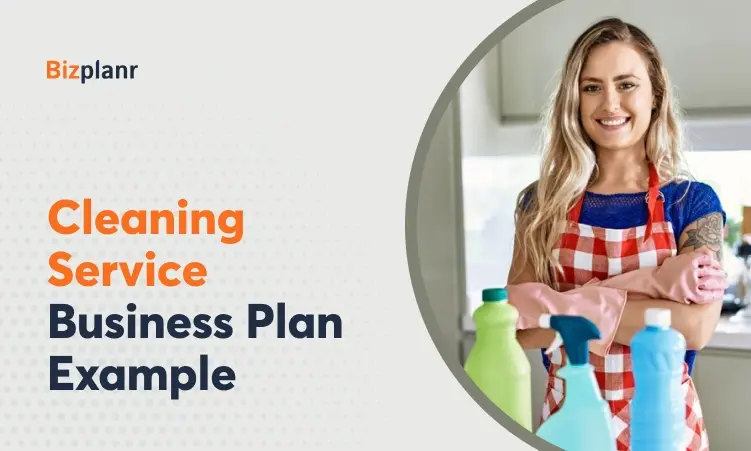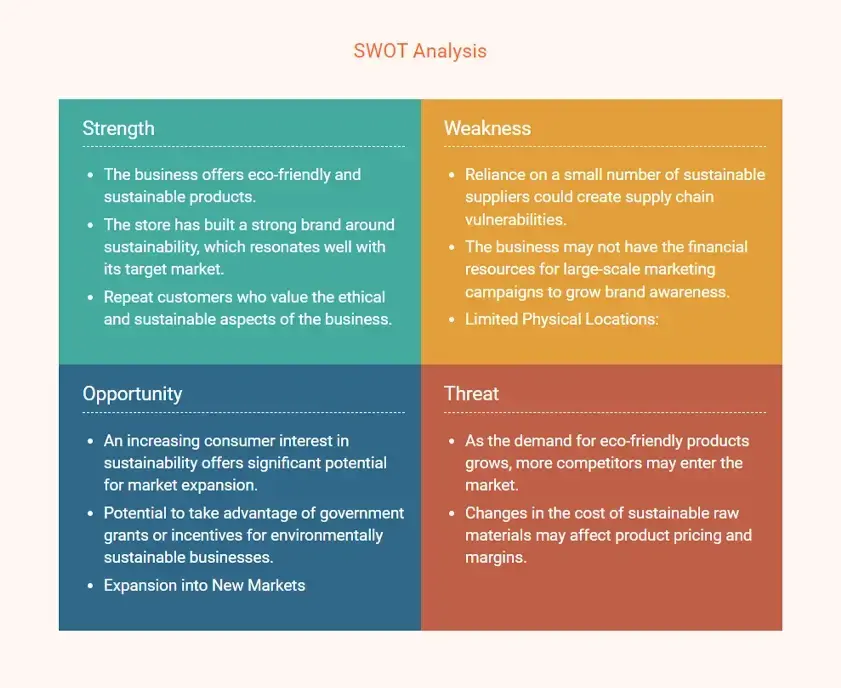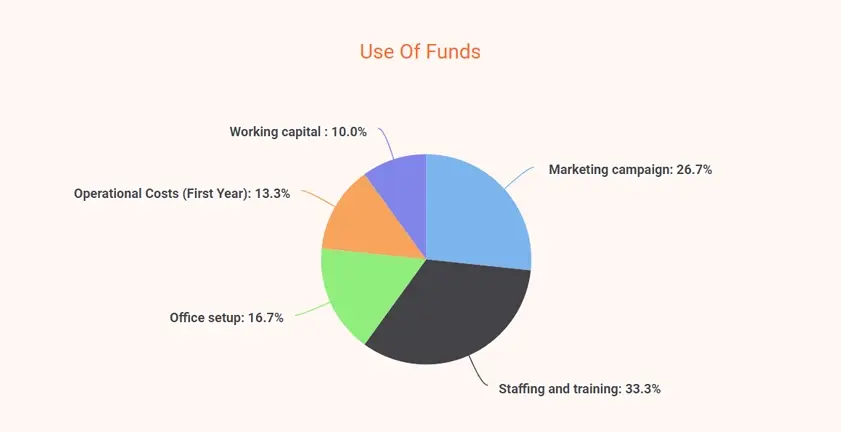Every day, countless people take pride in having clean, well-maintained spaces—whether at home or work. As cleanliness becomes a top priority, the cleaning service industry is growing rapidly and was valued at $68 billion in 2023.
If you've been thinking about starting your own cleaning business, now could be the ideal time to turn your passion into a successful venture.
But, creating a solid business plan is key to helping you map out each step, from setting up your services to expanding in the future. Need a hand with your plan?
No worries! This cleaning service business plan template is designed to guide you through the process of writing a practical and effective business plan.
But first...
What is a cleaning service business plan?
A cleaning service business plan is a structured document that outlines a cleaning business's key strategies, financial projections, and operational details.
It covers the business’s goals, an analysis of the market, the target audience, the services offered (residential, commercial, or specialized cleaning), pricing strategies, marketing plans, organizational structure, and growth objectives.
This plan serves as a roadmap for starting, managing, and expanding the cleaning business, helping with the challenges of the competitive cleaning industry.
Why do you need a business plan for a cleaning company?
You may be an experienced cleaner looking to expand your services or a newcomer launching your first cleaning business, having a business plan is essential to achieving your goals.
Here are the main reasons why you should write a business plan for your cleaning company:
- It serves as a detailed roadmap that guides your cleaning business’s daily operations and long-term growth strategy.
- It shows the financial potential and viability of your business, helping to secure investors’ confidence and obtain funding.
- It allows you to prepare for potential challenges and develop strategies to overcome them.
- It details the key business operations (such as scheduling, staffing, and supplies) to ensure the smooth running of your cleaning services.
- It helps you analyze competitors and effectively position your cleaning company in the market.
- It enables you to identify your target customers and build strategies for attracting and retaining them.
In short, creating a solid business plan is important for guiding your entrepreneurial journey and ensuring the success of your cleaning company.
Next, let’s explore what to include in a cleaning service business plan and how to make it attractive to investors.
How to write a cleaning service business plan
Writing a cleaning service business plan helps ensure the success and growth of your cleaning business. Here's a guide on how to write each key section of your cleaning service business plan:
1) Executive summary
The executive summary provides a brief introduction to your cleaning service business plan. It should be written last, as it summarizes the key sections of your plan.
Start by explaining your business concept, whether it's residential, commercial, or specialized cleaning services, and mention your location and current business status (startup or established).
In this section, you should include a quick overview of:
- The cleaning service industry
- Your target market and competition
- Your marketing strategy
- Key members of your team
- Financial highlights
The goal of the executive summary is to grab the reader’s attention and encourage them to read further. Keep it concise, clear, and engaging.
Liking the plan you're reading? It's AI generated.
Generate Your Own Using Bizplanr AI
2) Company overview
In this part, you can move into a more detailed description of your cleaning service business beyond the executive summary to give a fuller picture of what your company is and will become in the future.
When writing your business review, include information such as:
- Your business name—Sole proprietor, partnership, or an LLC?
- Talk about the guiding principles of your company and your aspirations for the future, highlighting what sets your cleaning services apart and your long-term goals.
- Name of business owner, partner?-Briefly describe his/her functions.
- Explain your company’s past, its origins, and any noteworthy successes such as winning over primary clients or expanding the set of services you provide.
- Discuss the particular laws or guidelines your cleaning business complies with, covering important points such as required licenses, insurance, and safety standards for cleaning tools and materials.
This section assists in providing an understanding to anyone reviewing your business plan about who you are, how your business is structured, and your future goals.
3) Market analysis and target customer
In this section of your cleaning service business plan, you’ll present a thorough analysis of the cleaning industry, market trends, and your intended customer base.
Begin by conducting in-depth market research to get a clear picture of the niche your cleaning business will serve. This will help you identify the demand for cleaning services and understand the specific clientele you aim to reach.
Here’s how to structure this section:
- Summarize the cleaning services industry size, trends, and growth potential.
- Assess local demand, market size, and growth projections.
- Identify key suppliers and analyze your competitors.
- Define your customer segments based on demographics and psychographics.
- Break down your audience by their unique needs.
Example target audience
- Homeowners aged 30-50, seeking affordable, flexible cleaning services.
- Office managers require consistent and detailed cleaning solutions.
- Managing apartment complexes, needing regular and reliable maintenance cleaning.
- Hospitals or schools, prioritize high-standard, specialized cleaning services.
4) Cleaning service and offerings
This area explains the cleaning services and solutions you offer in a broad outline. It’s exactly how your cleaning service will meet the requirements and desires of your target user.
Begin with the description of the cleaning services you offer and how much you charge as it makes it completely clear for anyone.
Example: House cleaning, commercial cleaning, deep cleaning
You can also showcase some of your value-added services such as environmentally friendly cleaning products, carpet and garden cleaning, or move-in/move-out packages.
5) Competitive analysis
This section focuses on identifying both direct and indirect competitors in your market. It helps assess their strengths and weaknesses to better position your cleaning service.
It’s advisable to concentrate more on direct competitors since they provide services similar to yours. For each competitor, analyze how they operate, their pricing, strengths, weaknesses, and customer base.
Now, direct competitors are nothing but other cleaning companies offering similar services, while indirect competitors could include janitorial supply stores or even individuals offering freelance cleaning services.
This insight helps uncover opportunities to differentiate your business. For example, you might offer eco-friendly cleaning products, more flexible scheduling, or competitive pricing to stand out.
SWOT analysis
Along with competitive analysis, a SWOT analysis will provide a deeper understanding of your cleaning business:
- Strengths: Show what sets your business apart, such as exceptional customer service, specialized cleaning techniques, or advanced cleaning equipment.
- Weaknesses: Identify areas for improvement, like limited resources or lack of market presence.
- Opportunities: Explore growth areas like targeting new markets, offering green cleaning options, or expanding services.
- Threats: Acknowledge potential risks, such as increased competition, rising costs, or changing regulations.
Here’s a sample cleaning business SWOT analysis:
6) Organization and management
The success of a cleaning service business isn't solely based on its service quality or marketing strategies. It also depends on strong management teams who are key contributors to long-term success.
This section should exactly cover the structure of your cleaning service business, detailing the leadership team and key personnel.
Be sure to mention all essential roles, such as the owner, operations manager, cleaning supervisors, customer service representatives, and cleaning staff. Include their roles, responsibilities, qualifications, and relevant work experience.
Also, have an organizational chart to visually represent how your team is structured and how the key roles interact. Here's an example:
7) Financial plan
This helps the investors with a clear understanding of your business’s expenses, revenue streams, startup costs, profitability, liabilities, and overall fiscal health.
This section should clearly show the long-term viability of your business and its growth potential.
In your cleaning service financial plan, try to include the following key financial statements and reports:
- Sales & revenue forecasts
- Income statement (Profit and loss statement)
- Cash flow estimates
- Balance sheets
- Funding needs and use of funds
Here is an example of a visualization of the use of funds:
Download a sample business plan for a cleaning service
Wasup so, are you ready to begin writing your cleaning service business plan but need a bit of guidance? We got you! Here’s our comprehensive cleaning service business plan pdf to help you get started.
This detailed template is designed specifically for entrepreneurs seeking support in cleaning service business planning. Simply import the data into the editor and customize it to fit your unique needs.
Conclusion
Now that you have a clear understanding of all the essential sections of a cleaning service business plan and how to draft them, creating a detailed plan should be much easier.
If you have any questions about presenting your plan or need additional assistance, consider using an AI business plan creator. It can help you draft a cleaning service business plan more efficiently and quickly.
So, don’t wait any longer—start your cleaning service planning today!
Get Your Business Plan Ready In Minutes
Answer a few questions, and AI will generate a detailed business plan.
Frequently Asked Questions
Do I need a business plan for a cleaning company?
Yes, a business plan plays a vital role for any company, including a cleaning service. It helps you develop your goals, structure your business operations, and guide you during growth.
Business planning is particularly essential when seeking funding, as banks or investors will anticipate that you have taken care of all essential elements of your business in your strategy. It’s beneficial in maintaining focus and assessing your accomplishments over time.
How do you get funding for my cleaning company?
There are several ways to get funding for a cleaning company. One option is to use personal savings or ask family and friends for a loan. You can also apply for a business loan from a bank or credit union. Some entrepreneurs turn to microloans, which are small loans aimed at startups or small businesses. Grants are another option, though they’re often competitive. If you have a solid business plan and can show profit potential, you can also attract investors who want to back your business.
How long should my cleaning services business plan be?
Generally, a business plan for a cleaning company can be anywhere from 15 to 30 pages. It needs to explain your business concept, who your customers are, how you plan to market to them, what your costs and revenues will be, and how you plan to grow.
It doesn’t have to be overly detailed, but clear enough for a reader to understand your business and its potential.
How to create a financial projection for a cleaning business plan?
To create a financial projection, start by estimating your startup costs—this could include things like cleaning supplies, equipment, uniforms, and marketing. Next, think about how many customers you expect to serve and how much you will charge them. Estimate your monthly revenue based on that.
Don’t forget to factor in your operating expenses, such as rent, utilities, transportation, salaries, and insurance. Finally, create a profit and loss forecast for the next 3-5 years, showing how your revenue will grow and how your expenses will change over time.
What should I do after completing my cleaning service business plan?
Once you’ve completed your business plan, take the time to review it and ensure it’s clear and realistic. If possible, get feedback from a mentor or business advisor. Then, use the plan to apply for loans or seek out investors.
You’ll also want to start taking the necessary steps to register your business, such as obtaining the right licenses and insurance. Once everything’s in place, you can begin implementing your marketing plan to attract customers and get your business off the ground.










